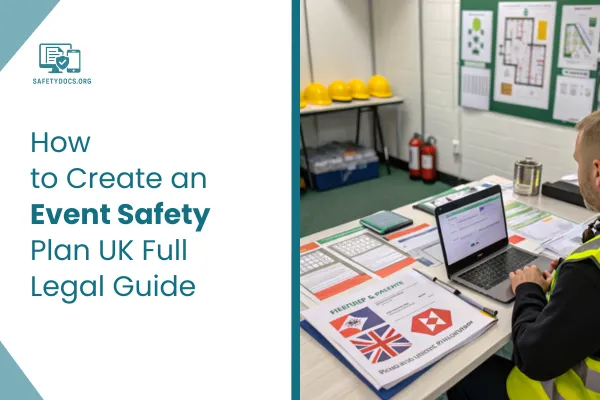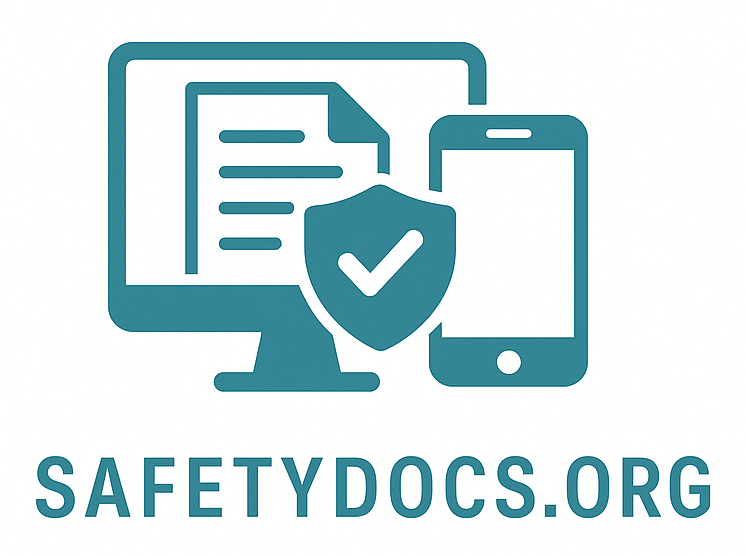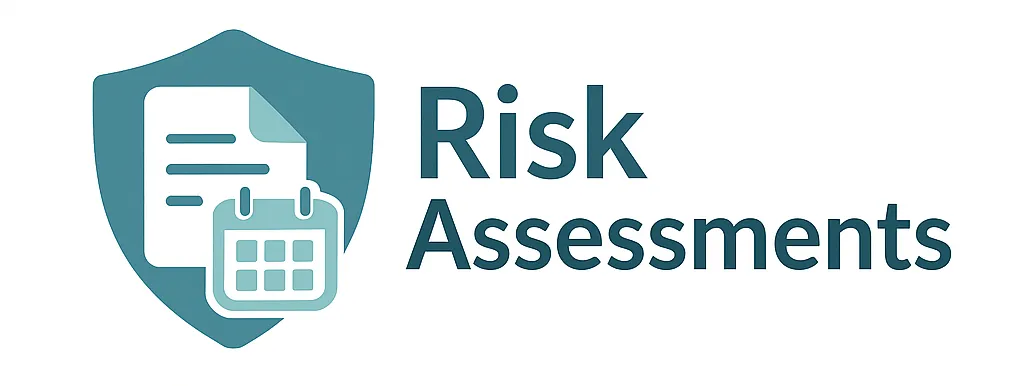
Create Event Safety Plan UK: Full Legal Guide
How to Create an Event Safety Plan UK: Full Legal Guide
Event safety is not just about common sense. In the UK, organisers are legally required to protect the public, workers, and contractors at all times during any event. Creating a plan means more than noting a few hazards. You need a complete document that shows how risks will be managed. Whether your event is held indoors or outdoors, whether it's small or large, you must have proper control measures in place.
In this blog, you will learn how to create an event safety plan in the UK using proven steps. It’s based on UK government guidelines and actual event planning standards. The aim is to give clear, reliable advice in simple terms.
What Counts as an Event in the UK?
An “event” includes a wide range of activities where people gather. These may include:
Music festivals and concerts
Sporting events
Local fairs and markets
Conferences or exhibitions
Charity fundraisers
Private parties with over 30 guests
Public celebrations or marches
If your event involves crowds, loud music, food stalls, or alcohol, you're more likely to face strict safety checks.
Legal Duties Every UK Event Planner Must Follow
UK law requires that event organisers protect people from harm. These duties apply even to volunteers and unpaid staff. Here are the main legal rules you need to know:
Health and Safety at Work Act 1974: You must ensure the health, safety, and welfare of everyone involved.
Management of Health and Safety at Work Regulations 1999: You must assess risks and act on them.
Regulatory Reform (Fire Safety) Order 2005: You must prevent fire and have emergency procedures.
Licensing Act 2003: Needed for alcohol, music, or late-night food.
Equality Act 2010: You must ensure access is fair for people with disabilities.
Ignoring these rules can result in significant fines, cancellation, or even criminal charges.
First Step: Do a Full Risk Assessment
You cannot make a safety plan without knowing the risks. This starts with a complete event risk assessment.
Key steps to follow:
1. Spot hazards – wet floors, large crowds, electricity, heat, sharp objects, etc.
2. Identify who could be harmed – staff, guests, performers, children, and disabled persons.
3. Evaluate the risk – How likely is it? How serious would it be?
4. Control the risk – Use barriers, signs, staff, or changes in layout. to mitigate the risk
5. Record your actions – Keep notes and update if anything changes.
The assessment must be shared with your event team, and copies should be on-site.
Plan for Medical Help and First Aid
You must have first aid on hand. The level depends on the size and type of your event.
Basic first aid planning includes:
Enough trained first aiders
Visible first aid stations
Signs showing where help is
Quick access for ambulances
A clear emergency number list
For significant events, you may need a medical provider on standby or even a treatment tent.
Don’t Ignore Fire Safety
Every event must have a fire safety plan in place. Fire can spread fast in crowded spaces. You must think about:
Exit routes and fire doors
Fire extinguishers in key spots
No-smoking rules
Gas safety for food stalls
Staff trained in fire response
The fire risk assessment is often included in the main risk report, but a separate document may be required depending on the venue.
Safe Venue Layout and Facilities
Your site layout affects how people navigate and how effectively you manage risks. Make a clear map showing:
Entry and exit points
Toilets and water stations
First aid and lost child areas
Food and drink vendors
Fire points and emergency access
You should also include lighting, fencing, and how you'll manage people with disabilities.
Ensure paths are wide enough to accommodate buggies, wheelchairs, or stretchers. Don’t block any emergency exits with gear or decorations.
Crowd Management and Entry Control
Crowd control is one of the highest-risk areas. Too many people in the wrong place can cause crushes or panic. Use these methods:
Count attendees at entry
Use stewards or security teams
Plan for queues with barriers
Keep clear exit paths
Avoid bottlenecks in small areas
You may also need wristbands or stamped tickets to control re-entry or age limits.
Emergency Plan and Staff Briefing
What happens if something goes wrong? You need a comprehensive emergency response plan, and everyone working the event must be familiar with it.
Include in your emergency plan:
Evacuation steps
Key contact numbers
Who does what in a crisis
Maps showing exits and shelters
Communication systems (radios or phones)
Hold a safety briefing before the event opens. Walk through the site with your team. Answer questions and give written instructions if needed.
Working with Local Authorities and Services
Significant or public events should contact the local Safety Advisory Group (SAG) for guidance and support. This includes the police, ambulance service, fire brigade, and council.
You’ll need to give them:
Your risk assessment
Public liability insurance
Emergency plan
Site map and layout
Crowd numbers and ticket process
SAG meetings help everyone prepare. They suggest extra controls or approve your plan as it is.
Set Roles and Train Your Team
Assign clear safety roles and ensure that everyone knows their responsibilities. Common roles include:
Event safety manager
Fire marshal
First aid lead
Security manager
Site manager
Train your team in basic safety, what to do in emergencies, and how to report problems. Use radios or other tools to keep in touch.
Hygiene, Waste, and Toilets
Good hygiene matters, primarily if your event serves food or lasts more than a few hours.
Your safety plan should include:
Enough toilets for your expected crowd
Handwashing stations
Waste bins are emptied regularly
Clean-up teams are on schedule
Food safety checks on vendors
Dirty conditions can lead to illness, complaints, and fines from local councils.
Public Liability Insurance and Legal Cover
Insurance is not just a formality. It can protect you from legal claims if someone is hurt or property is damaged.
You may need:
Public liability cover
Employers’ liability (if you have staff or volunteers)
Cancellation insurance
Equipment damage cover
Check what your insurer requires. Some insurers won’t issue coverage unless you submit a comprehensive event safety plan.
Inclusion and Accessibility
You must plan for people with disabilities. The law requires you to make reasonable adjustments to help them participate safely.
Add these to your plan:
Ramps and step-free paths
Accessible toilets
Clear signs in large print
Hearing support if needed
Quiet areas for those with sensory needs
Ask attendees about access needs before the event.
After the Event: Review and Improve
Safety work does not stop when the event ends. Review how things went and update your documents for next time.
Do a post-event review:
Did any accidents happen?
What complaints were made?
Did staff follow the safety plan?
What can be improved?
Utilize feedback from your team, attendees, and external services such as police or fire crews. This makes your next event safer and better prepared.
Food Safety and Vendor Compliance
If your event includes food stalls or catering, you’re legally responsible for food hygiene on site. Vendors must be registered with their local council and follow UK food safety laws.
Your plan should confirm that each vendor:
Holds a valid food hygiene rating
Has a Level 2 Food Safety Certificate
Provides allergen information clearly
Uses clean, working equipment
Handles food with gloves or tools
Request copies of certificates in advance of the event. Assign someone on-site to check that rules are being followed during setup and serving hours.
Weather-Related Risk Planning
Outdoor events in the UK must prepare for rapidly changing weather conditions. Rain, wind, or extreme heat can turn minor risks into major ones.
Include these weather controls in your safety plan:
Non-slip mats or flooring for wet areas
Secured marquees and tents (check wind ratings)
Water stations and the shaded regions during the heat
Lightning protocol for open spaces
Regular weather monitoring before and during the event
Have a backup plan ready. That could mean delaying entry, closing high-risk areas, or cancelling parts of the event if conditions worsen.
FAQs
1. What are the key steps to ensure safety at public gatherings?
Start with a thorough risk assessment, include first aid provisions, manage crowds carefully, and have a clear emergency plan in place.
2. How do I handle fire safety during events?
Ensure all exits are accessible, install fire extinguishers, train staff on fire response, and keep evacuation routes clear at all times.
3. Who should be involved in planning event safety?
Include a safety manager, security personnel, and first aid staff, and communicate closely with local authorities and emergency services.
4. How can I manage medical emergencies on-site?
Have trained first aiders available, set up designated first aid stations, and ensure rapid ambulance access throughout the event.
5. What should I consider for outdoor event safety related to weather?
Monitor weather forecasts regularly, secure structures, provide shelter or shade, and prepare backup plans for extreme conditions.
Conclusion
Planning an event means more than picking a date and selling tickets. You must protect guests, staff, and the venue at all times. By following the steps above, you can create a UK event safety plan that meets all legal standards and protects your event from risk. A clear, updated, and shared safety plan helps everyone perform effectively, ensuring the event runs smoothly without problems.

